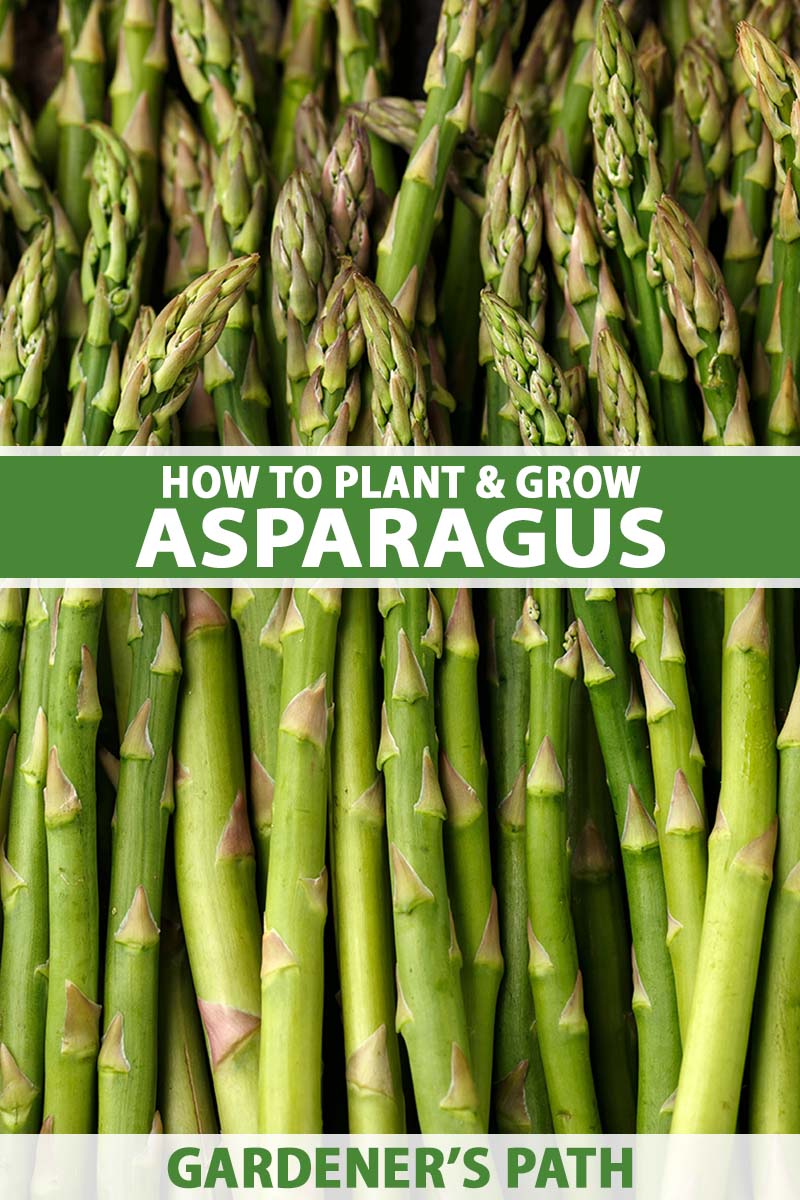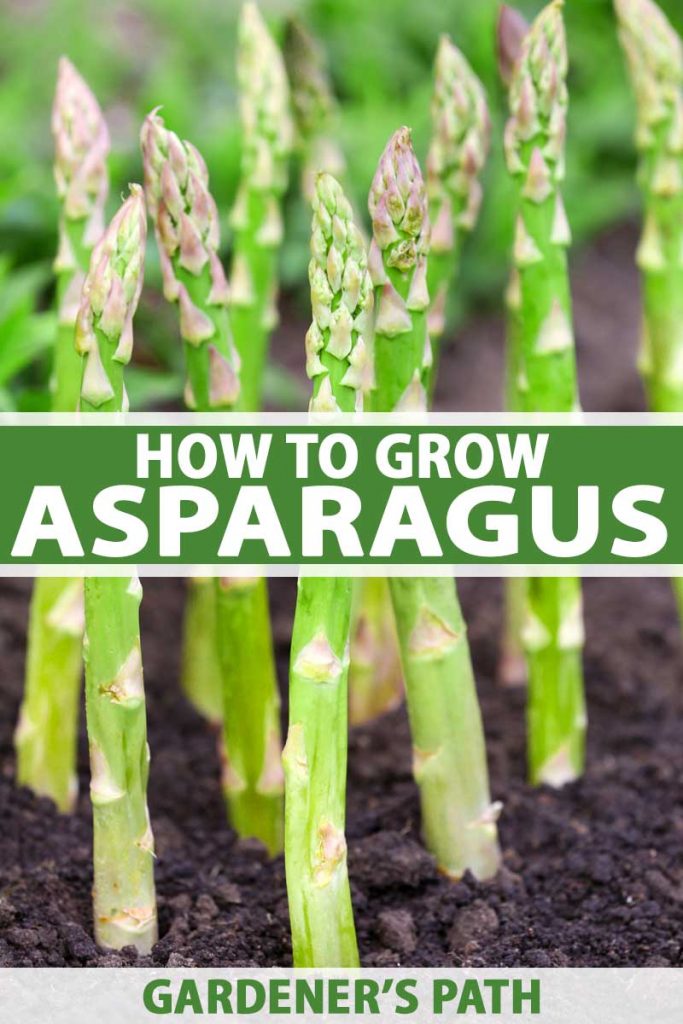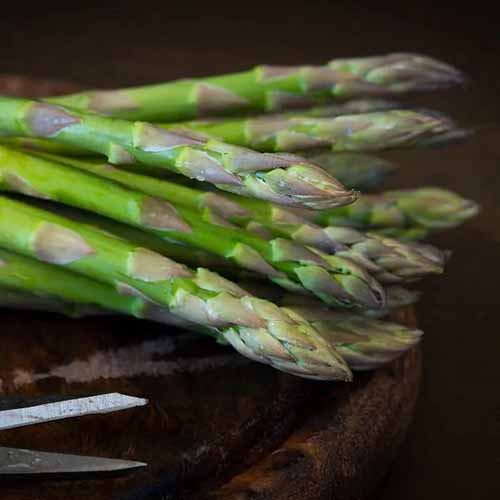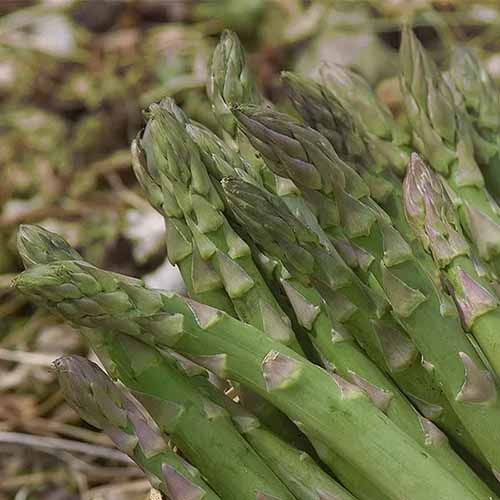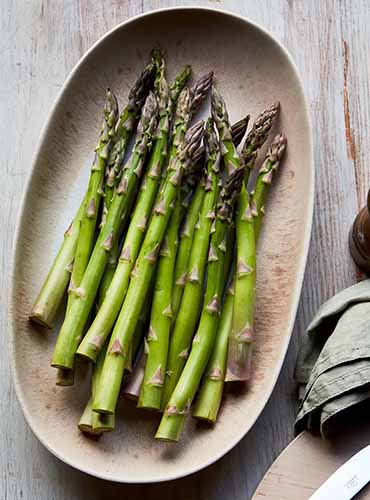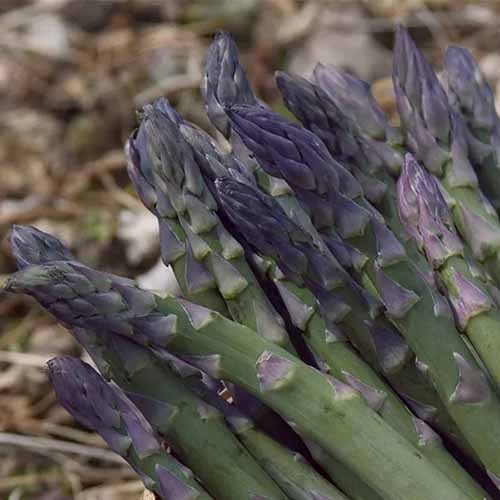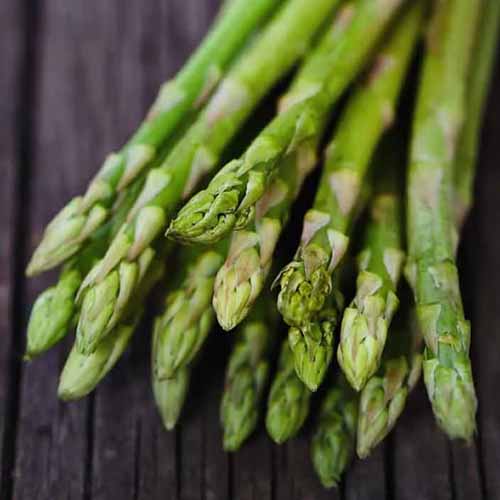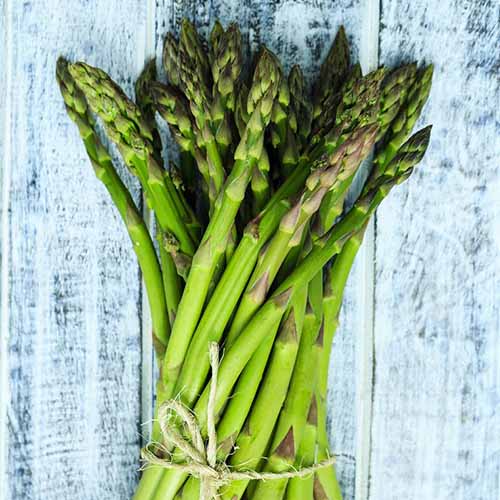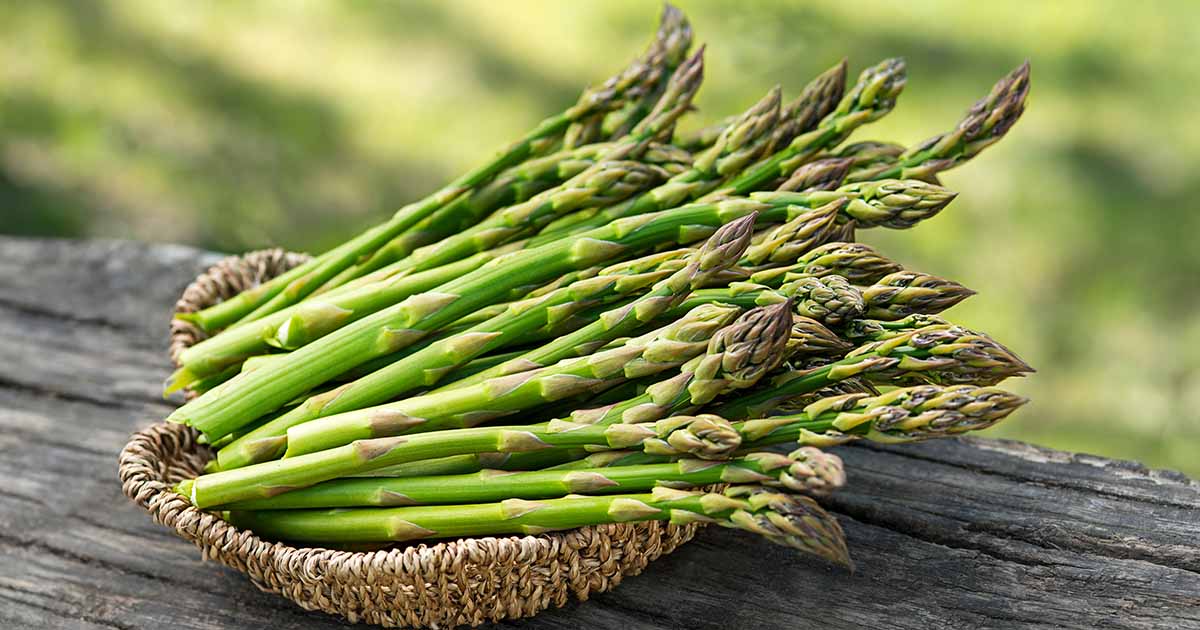
Asparagus officinalis
There are the veggies that pretty much every gardener keeps around and then there are the species that are reserved for the advanced growers.
Asparagus is often considered one of the latter, but it doesn’t need to be that way. Those delectable spears aren’t really as difficult to grow as many people seem to think.
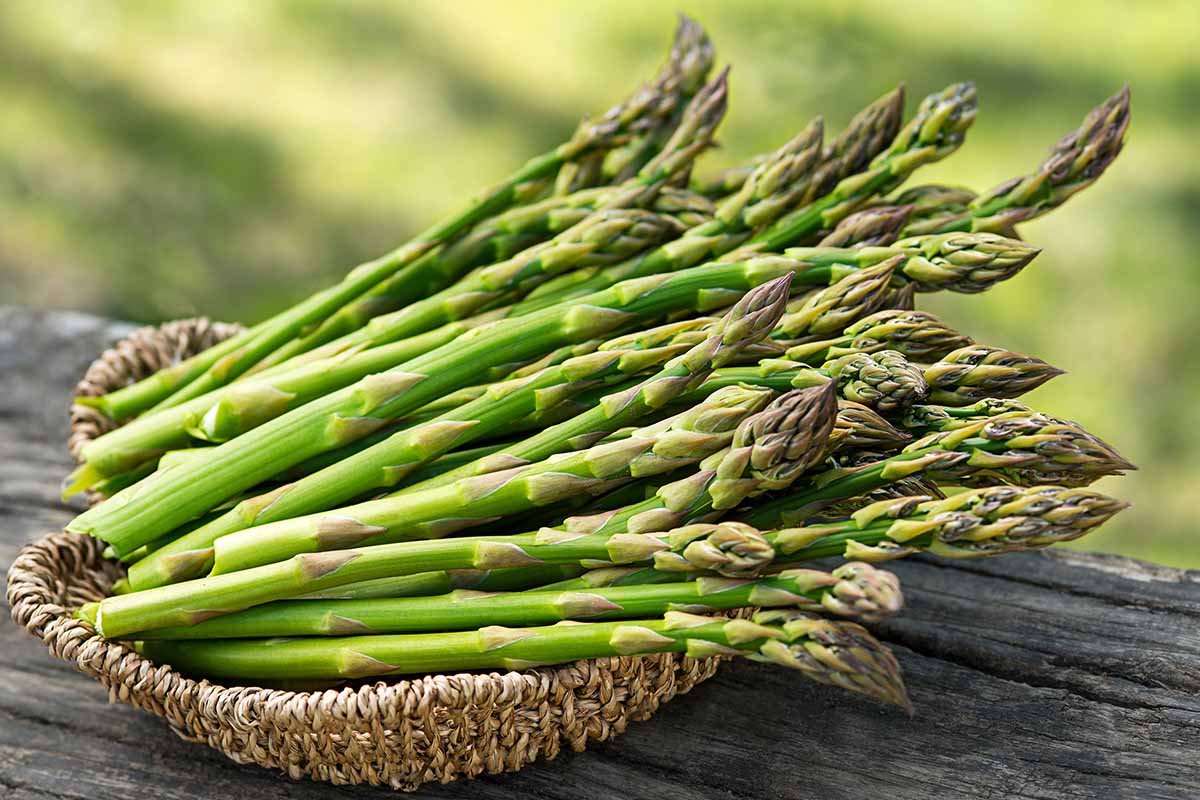
We link to vendors to help you find relevant products. If you buy from one of our links, we may earn a commission.
I think part of what people trip over is the fact that asparagus plants are perennials and it’s the stem that we eat, not the fruits that the plant produces.
Some growers aren’t sure what to do with the ferns or how to put the seeds in the ground.
But put those fears aside. You’ve got this! This guide will help.
In order to attain the status of asparagus-growing pro, here’s what we’ll go over in this guide:
Cultivation and History
Asparagus (Asparagus officinalis) has a controversial past.
While perusing accounts of its history, you will find some debate over its true origins. But I’m sure the conflict is unintentional and I’m still fascinated about where this discrepancy may have cropped up.
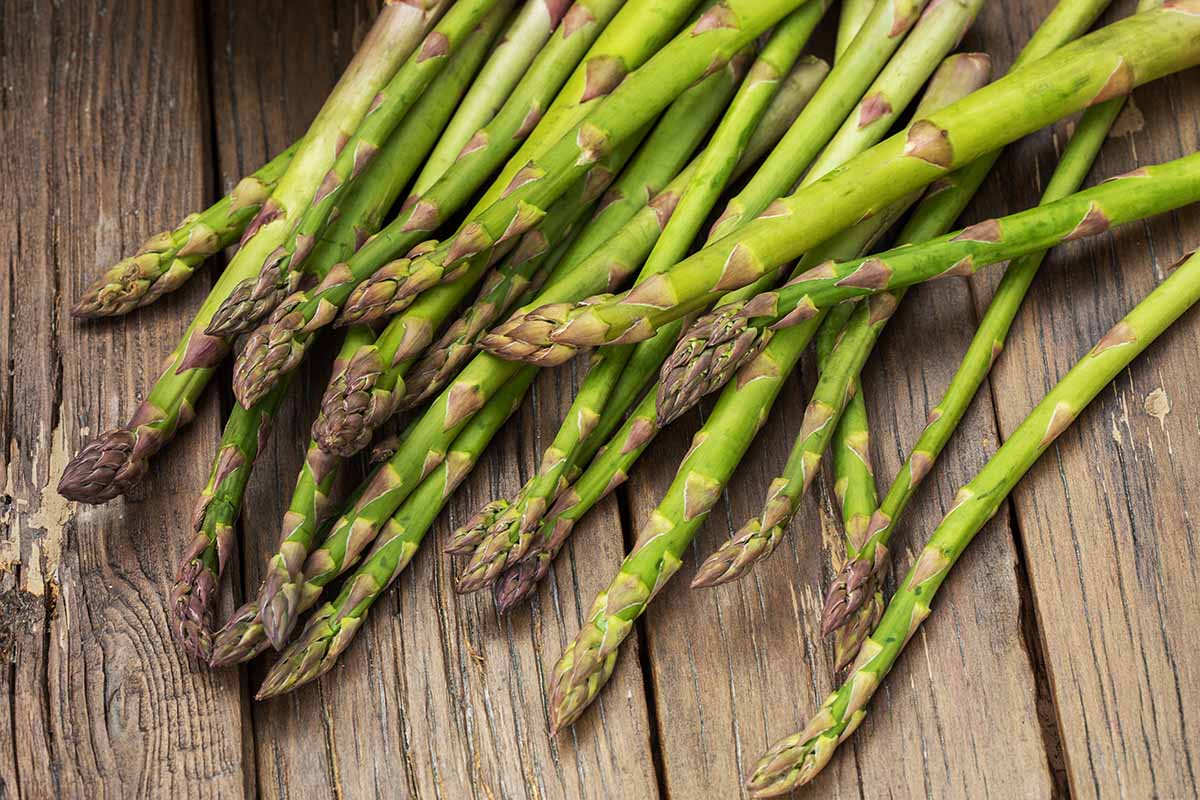
Perhaps it comes from the fact that there are around 300 species within the Asparagus genus, native to locations spanning the globe.
Some claim this cut-and-come-again veggie has ancestors hailing from boggy, lowland moors. Some sources go so far as to say it’s a native of Scotland and the British Isles!
In truth, this fernlike distant relative of onions and garlic (once sharing the same family, Amaryllidaceae) is widely presumed to be local to the Mediterranean coastal regions of Europe and Asia, as well as the Himalayan region.
Today, it is found wild in Europe, northwest Africa, and Asia. It has also been introduced to the wild in North and South America and Australia.
According to most historical accounts, a wild ancestor of asparagus was foraged and enjoyed by the ancient Egyptians, Greeks, and Romans.
Beginning around that time, it was bred from a feral plant into the widespread, globally popular cultivated culinary victual that it is today.
With more wild asparagus being found in countries like Italy and Greece than any other, it is likely that these stalk-producing crowns are Mediterranean in origin.
During the Roman conquest and in later years, growing and eating the delicious, tender spears gained popularity and the plants spread to the rest of the world. In many cultures, it didn’t just catch on as a food, but was also revered as a medicine.
The name of the plant comes from the Greek asparasso, which means “to rip,” a reference to the spines on some plants.
Eventually, the word “asparagus” was transformed into a new folk term for the vegetable in English: “sparrow-grass,” a popular sobriquet still.
This vegetable was not always grown for food. In fact, some might argue that it has a longer history as a medicine than it does as a delicious delicacy!
Many are acquainted with the strong smell you might experience during a bathroom trip after eating it – and this occurrence could have sparked its use as a diuretic and urinary medicine, to lower blood pressure, prevent heart disease, and help with kidney stones back in the old days.
The shape of the spears inspired its use in sexual healthcare, especially for men in improving fertility and performance while reducing impotence.
A close relative to the common edible asparagus, shatavari (A. racemosus), has applications for female health, too.
It is used in Ayurvedic medicine to treat many female reproductive imbalances, including PMS, irregular periods, menopause symptoms, and more.
Interestingly, today there are studies supporting a lot of these classical uses.
Recent research published in the Journal of Agricultural and Food Chemistry by Matsuda Sanae and Aoyagi Yasuo, researchers at Kagawa Nutrition University, pointed out notable kidney effects in line with traditional use.
Plus, asparagus spears are high in fiber, iron, calcium, manganese, vitamins A and C, B vitamins including folate, and especially vitamin K – making it a healthy veggie no matter how you prepare it!
Asparagus Propagation
When growing asparagus, the most popular method for starting your patch is by planting crowns.
Otherwise, you can propagate asparagus from seed, though the method is more difficult, slower, and can yield more female plants than male – which may cut into how many spears you produce. That’s why crowns are preferable, though seed sowing is more affordable.
Before you plant using either method, test your soil to see if it is deficient in any nutrients and amend accordingly.
The soil needs to have a pH around 6.5 to 7.0. Asparagus cannot grow in very acidic soil.
It’s best to do this work in the fall before spring planting, but the spring works as well if you aren’t able to amend in advance.
From Crowns
Crowns are typically year-old, single root systems that can be transplanted to start a new patch. You can order crowns online or find them at local nurseries.
Plant the crowns in the spring, after the last predicted frost date and when the soil can be worked.
This will give them enough time to build strength and become established throughout the warm season.
Crowns should be spaced one foot apart.

If digging a trench for a row for five crowns, for example, you may want to prepare a bed with a 10-foot row. In a circular-shaped patch, make it ample enough to keep your plantings evenly spaced.
Regardless of whether you amended your soil to correct for any pH issues or deficiencies, add compost or your chosen fertilizer to the prepared bed, and work it in.
Then, dig shallow, wide holes for each crown to sit in if you aren’t trenching.
When planting the crowns, lay the root mass lengthwise with each plant facing the same direction into the hole, and take care that the actual “crown” – the knotty mass where all the roots join together – is planted facing upwards.
This is where the asparagus spears will emerge from, pushing their way up through the ground.
Cover the crowns with a thick layer of well-rotted compost mixed with earth. The crown should lie somewhere between six inches and a foot below the surface of the soil.
The most necessary step for nearly all gardening projects comes next: watering!
Give them a good, deep watering immediately after planting. If the soil settles a bit, add more compost and soil mix.
After watering, it’s a wise choice to mulch over your patch or row with a thick layer of organic matter – straw works best here.
This adds a little extra nutrition and moisture retention, protection through cold weather, and helps to reduce weeds for less competition – and bigger spears!
From Seed
If you’d like to go the seed route, soak them for a few hours before you plant them in mid-winter. January or early February is best.
Fill a deep seed tray with a seed-starting medium. Moisten the medium and plant the seeds a half-inch deep.
The seeds should be kept warm, so place the tray on a heating mat, unless you keep the area consistently above 70°F.
It can take up to eight weeks for the seeds to germinate. In the meantime, keep the soil moist under grow lights or in a sunny southern window. Thin the seedlings to about six inches apart once they’ve reached a few inches tall.
After they’ve germinated, it takes the seedlings about 12 weeks to reach the point where they can be moved outside.
At that point, transplant them as you would crowns, as described above.
How to Grow Asparagus
Asparagus plants need a spot in full sun with deep, well-draining soil.
If you keep your asparagus in a bed with other veggies or herbs, be sure to put it on the north end so it doesn’t shade everything else when it’s full-grown.
Remember that this plant can live for up to 20 years.

With an annual vegetable, you can plant it for the conditions of the current growing season without having to worry about what might happen in the following years, but that’s not the case with asparagus.
Note any trees or shrubs that might grow taller in the next few years around where you’re planting.
After transplanting your crowns, your first season will consist of watching them grow as the months go by. If a crown establishes itself successfully, you will notice your very first small asparagus spears emerging in the spring or early summer.
They will most likely be very tiny – only pencil-thin in circumference, or thinner – and you should not pick them at all, at least for the first year.
Instead, it is best to let them grow tall, spreading out their feathery, fernlike foliage to become fully established and grow strong.
Some prevailing gardening guides say that modern cultivars prefer swampy conditions, demanding constant moisture. More credible sources, however, coupled with our own experiences growing asparagus, find this to be completely untrue.
Growing asparagus in wet regions like the United Kingdom, Ireland, and the Pacific Northwest can be quite a hassle.
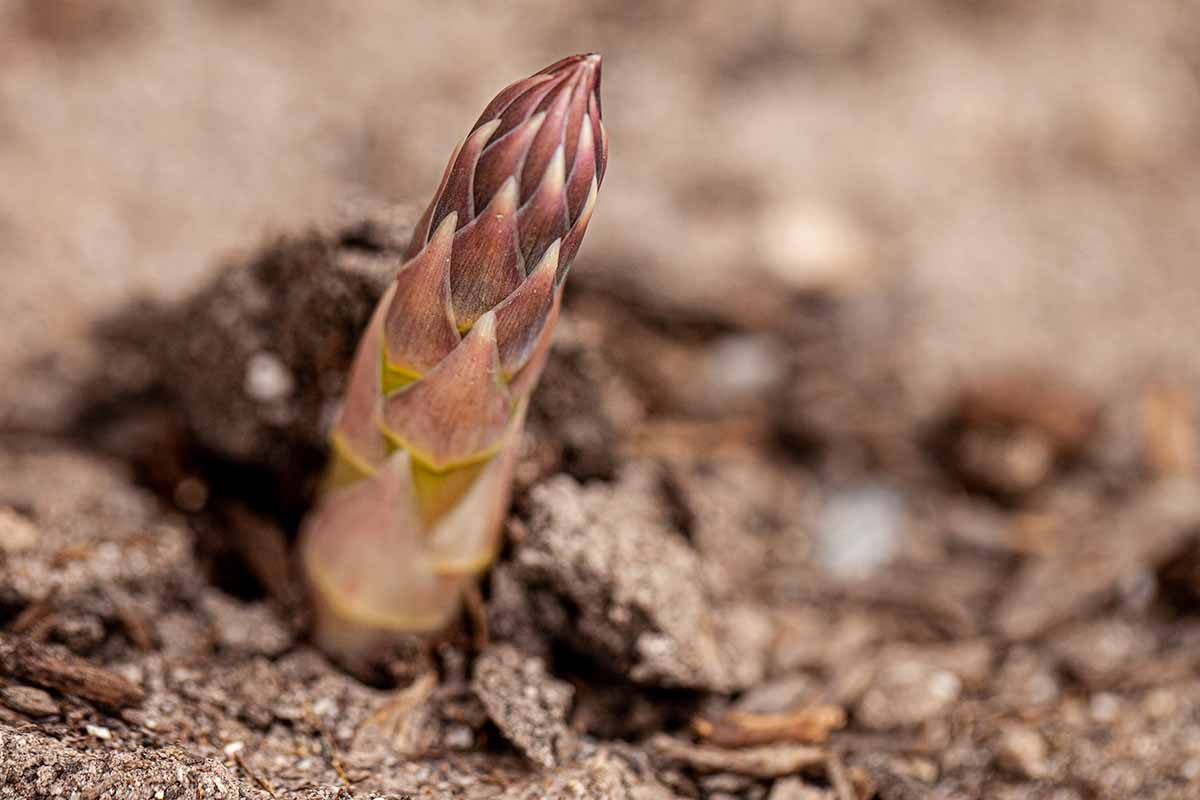
While the spears do emerge in spring in response to rainfall, excess water and clammy cold is a real bane to asparagus. Its reanimation in spring requires a well-drained site, warmth, and average – not heavy – rainfall to get it going.
Water sparingly throughout the first season as needed, especially during dry periods and in hot, arid regions. Once the top inch or two of soil dries out, it’s time to add moisture.
Again – for the first year, don’t harvest anything. Just let your plant be.
Besides leaving the aboveground parts of the plant to grow, an easy task, what else can you do to help your patch along?
If you experience a surprise late frost, cover the emerging spears with frost cloth or propped-up cardboard. Other than that, it’s a matter of feeding, trellising, and weeding.
Fertilizing
Many veggies don’t need to be fertilized regularly because we grow them for one season and then pull them out of the ground. But asparagus is a perennial that will be around for years, so you need to replenish the soil.
Sprinkle a mild, balanced pellet or liquid fertilizer near the plants but not touching them. Water the pellets in, if that’s what you use, but don’t dig them in as this will disturb the roots.
Avoid using high-phosphorus food because it can build up in the soil and damage the plant over time.
Trellising
As the fronds grow to tower over your patch, with some attaining heights over six feet, you can stake or trellis them if you like – though plants that have fallen over are not doing any damage to their health. In fact, falling over is how the female plants spread their seeds.
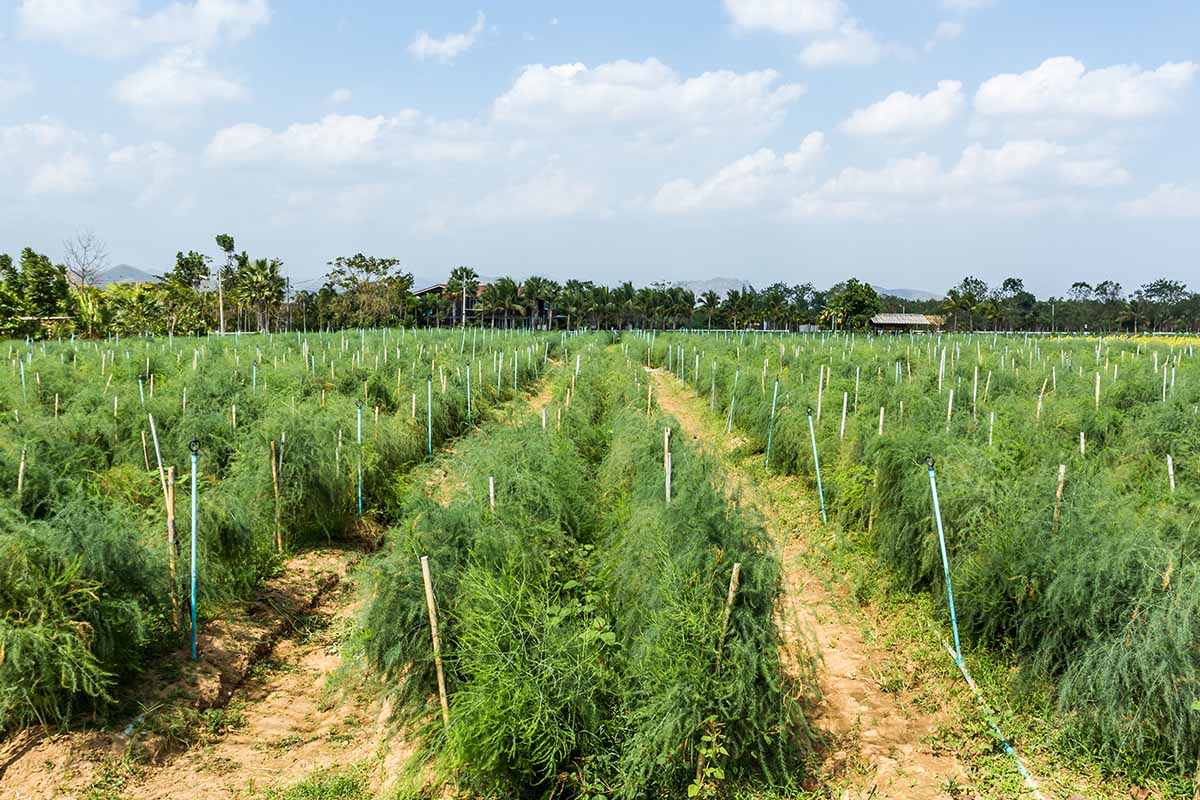
A simple way to do this: drive stakes in the ground around the perimeter, and run string around plants so they don’t topple to the ground.
Weeding
Weeding is one of the most important jobs when growing asparagus, particularly for young plants. Weeds steal nutrients, compete for light, and may harbor diseases and pests.
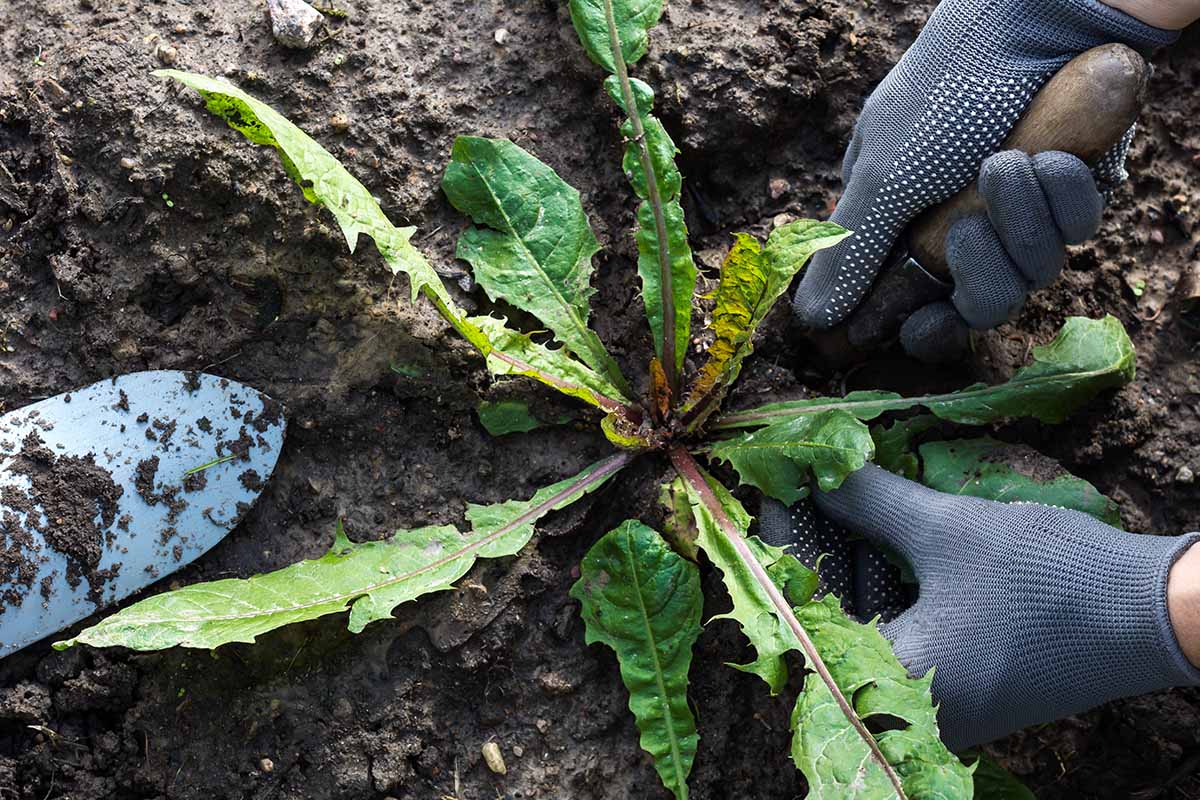
Hand-pull weeds to avoid disturbing the asparagus roots and avoid weeding in the spring when the shoots are just emerging, if at all possible.
The best times to weed are right before the spears emerge, and just prior to the ferns emerging.
A thick layer of mulch placed in between the plants can help to suppress weeds, so you don’t have to be as diligent. Straw is ideal for this.
As the plants mature, they can tolerate more vigorous weeding, since the roots can grow up to 15 feet deep.
Blanching
Have you ever seen or eaten beautiful white asparagus spears? These aren’t some kind of special cultivar. You can make any spear white if you want, through blanching.
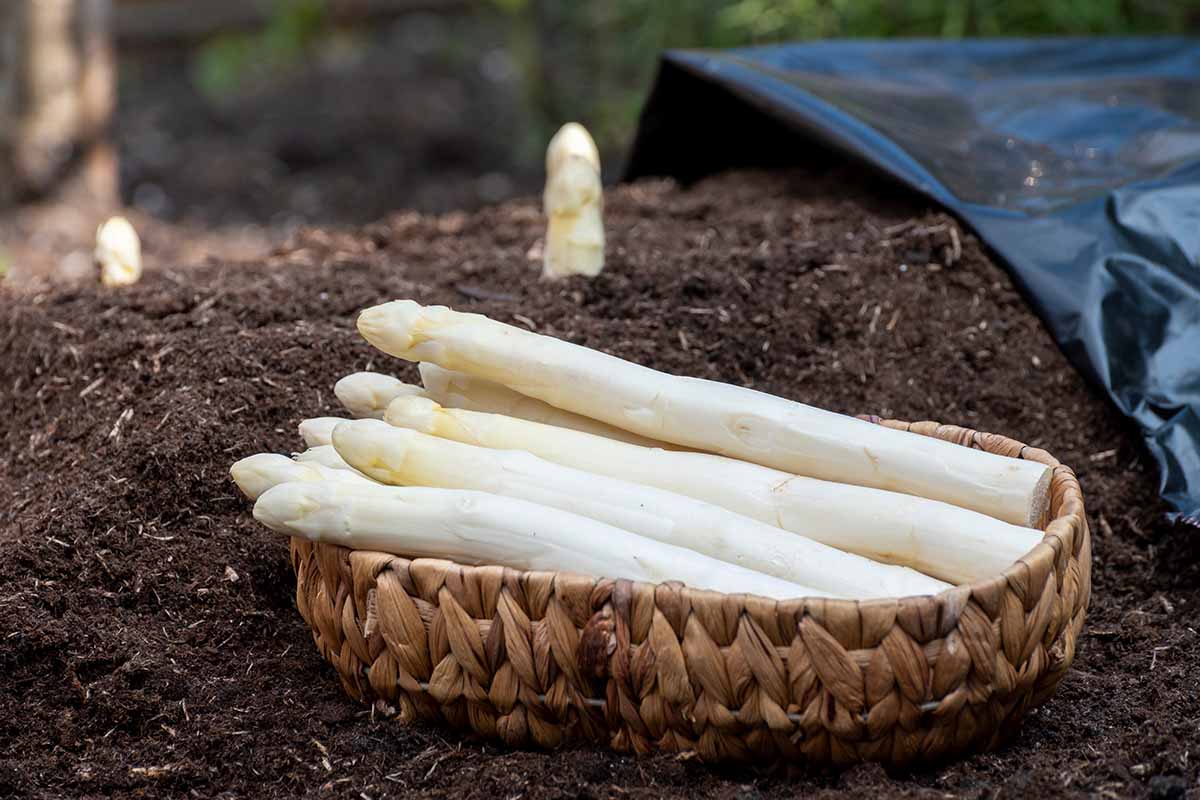
Blanching restricts sunlight exposure to the stalk of any variety, thus whitening it – a method used with certain other delicious crops as well, like Belgian endive, cauliflower, and celery.
There are a few ways to do this:
The commercial method is conducted through the use of special arched row covers placed over beds, which shield the plants from light in order to whiten them.
Another way is with a thick, two- to three-foot layer of loose straw mulch, placed over the beds before the spears emerge.
This blocks a good portion of the sunlight while allowing the spears to still grow and rise into the material where they can then be harvested after removing the mulch.
Growing Tips
- Plant in full sun with a soil pH of 6.5 to 7.0.
- Water when the top one to two inches of soil dry out.
- Weed regularly to prevent disease and encourage strong stalks.
Pruning and Maintenance
In the fall, it’s absolutely critical to cut back the fronds, or the leaves of the plant, at the right time.
The ferns are the factory that manufactures all the energy that the roots need to survive the winter and make new stems the following year. If you cut them off too soon, you deprive the plant of much-needed nutrients.
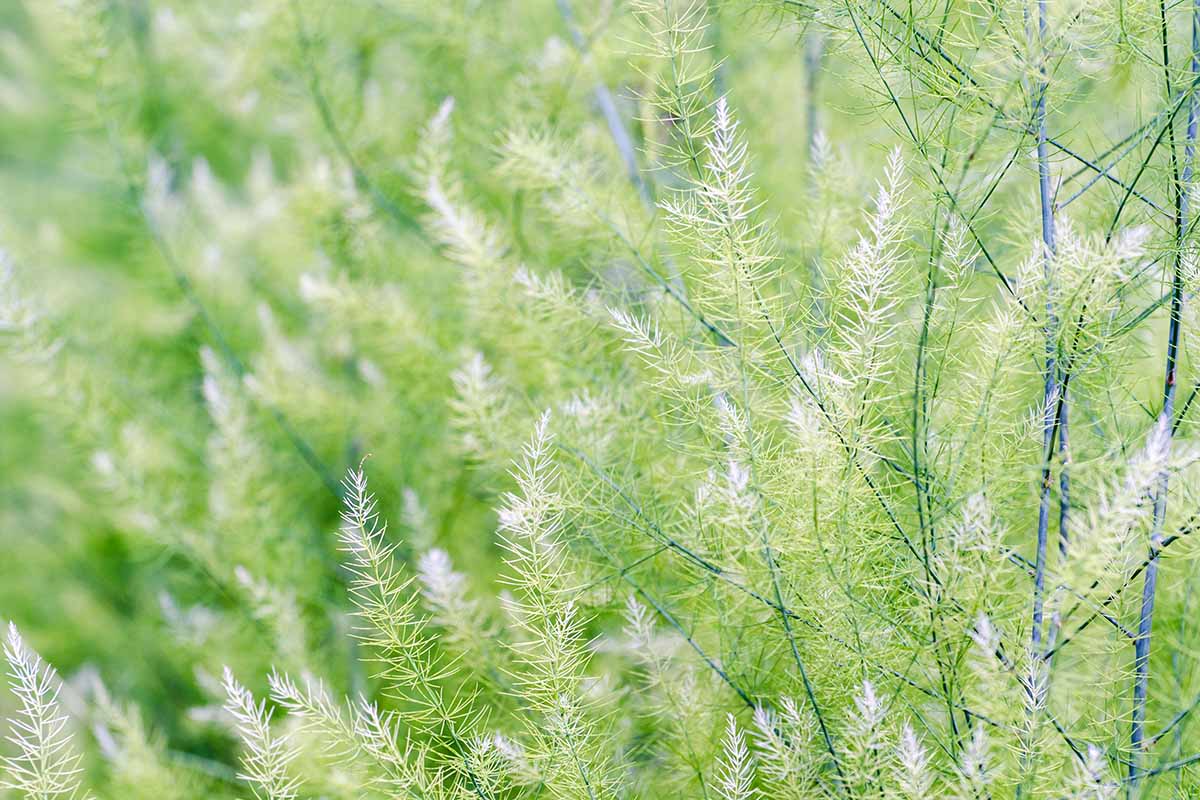
Wait until the first frost after the foliage has died back, turning yellow and brown. Then, you can cut them off at the soil level.
This should be done for the first two years. After that, you can remove the fern when you’re ready to harvest.
You can learn more about when and how to cut back asparagus foliage in our guide.
Adding extra mulch over the beds when all the spears are gone never hurts. A thick layer adds a bit more organic matter, nourishment, and moisture retention, and helps to keep weeds down.
In some cases, you may have to clear small holes for your spears to poke through when the start of picking season returns.
Early emerging spears might be damaged by late frosts. If you have an early emerging variety and late spring frosts in the forecast, you might need to head out and cover your plants in frost cloth or a lightweight blanket.
Asparagus Cultivars to Select
Asparagus crowns may have one of two different sexes, and the male’s ability to pollinate the females can greatly detract from their productivity in producing spears for food.
All-male cultivars are generally preferred since they don’t produce flowers and berries, so they don’t divert that energy away from producing new stalks.
If your asparagus fronds produce bright red berries at the end of the season, you know you have an heirloom variety with female plants, and yields may be somewhat lower.
We have an entire guide to help you understand the difference between male and female asparagus plants and why it matters.
If you’re looking for a large yield, it’s recommended to start with an all-male hybrid.
These almost always have the word “Jersey” in the name, as these cultivars were developed at Rutgers University in New Brunswick, New Jersey.
All-male hybrids are likely to produce up to three times more than heirloom varieties on average.
You’ll find green as well as purple varieties. But again – you won’t find white asparagus on this list since it’s made white in the garden through the process of blanching.
Jersey Knight
‘Jersey Knight’ has been a favorite for years, and it’s sadly about to become harder to find.
Along with ‘Jersey Giant’ and ‘Jersey Supreme,’ this is one of the primarily male New Jersey hybrids.
It’s a high-yielding hybrid bed by researchers at Rutgers University in the 1980s using ‘Martha Washington’ and ‘Jersey Giant.’
The producer of the Jersey asparagus, Walker Brothers, stopped propagating crowns in late 2021 with no known plans to sell their breeding lines to another producer.
But you can still find a few retailers that carry this flavorful, easy-going, adaptable plant for the time being. Nab a ‘Jersey Knight’ crown at Nature Hills Nursery while you still can!
Mary Washington
For a while there, Mrs. ‘Mary Washington’ was the standard-bearer for home and commercial growers.
Originally released in 1919, it has fallen out of favor in exchange for more productive hybrids, of which it’s often the parent.
Cultivated by Dr. J. B. Norton of the U.S. Department of Agriculture to be rust-resistant and to grow uniform spears, and lots of them, the thick stalks are tightly packed, giving you more bang for your square-foot garden buck.
Snag some for your veggie bed at Nature Hills Nursery.
Millennium
With the Jerseys out of commission, experts are recommending ‘Millennium.’
It’s every bit as adaptable, rust-resistant, and high-yielding as the Jersey hybrids. Actually, it’s far more productive, it just takes a few years to reach full productivity.
Fortunately, these plants also have a longer lifespan, so you can enjoy the nutty spears for almost two decades.
‘Millennium’ is another primarily male hybrid. Growers see an even higher percentage of male plants than with the Jerseys, and this variety can tolerate colder temperatures.
Sold? Me too, this is one of the best producers in my garden. Visit Burpee for packages of 25 bare roots and prepare to drown in deliciousness.
Sweet Purple
With its pretty purple hue and sweet, nutty stalks, ‘Sweet Purple’ is a delight for the senses.
The spears on this open-pollinated cultivar are larger than average and aren’t as stringy, either.
It was bred to appeal to gourmands, and it succeeds, with its crisp snap when fresh and its rich flavor when cooked.
Don’t cook it too long though, or the violet to blue-purple spears will take on a less attractive gray hue.
Nature Hills carries this pretty option if you’re looking to add some color to the garden and the table.
UC-72
An unimpressive name for an impressive veggie from the University of California.
But those asparagus-loving gardeners living in warmer regions should commit it to memory, because it’s a marvelous option.
‘UC-72’ is both drought and heat-tolerant, and resistant to rust and fusarium wilt.
Developed at UC Davis with ‘Mary Washington’ as a parent – which is why it’s sometimes called ‘Mary’s Granddaughter,’ – it has extremely large spears and will produce them continuously for two decades.
This hybrid doesn’t sacrifice flavor for productivity, either. It has a rich, deep flavor that will please the asparagus connoisseurs out there.
Visit Eden Brothers for a packet, ounce, or quarter-ounce of seeds.
UC-157
‘UC-157’ is a stellar hybrid that was developed by Professors Frank Takatori and Frank Souther from the Department of Plant Sciences at the University of California, Riverside in 1978.
Extremely high-yielding and resistant to fungal diseases like rust, it’ll probably come as no shock that this is one of the most popular types out there.
I recommend it to beginners all the time because it’s adaptable and tough while giving you a ton of tender stalks. But it’s also popular with experienced and professional growers for the same reasons.
You can purchase a small packet, ounce, quarter pound, or pound of seed at Eden Brothers if this one is calling your name.
Managing Pests and Disease
If your asparagus is ferning out, it doesn’t necessarily mean that your plants are sick, though it could.
It’s a normal part of asparagus lifespan, but untimely or excessive ferning could indicate a problem.
Read our guide to learn why this happens, and what, if anything, you should do about it.
Whether they’re ferning or not, insects and pests can be an issue that can reduce production. Let’s chat about those creepy crawlies, first.
Insects
Insects provide a double-whammy of evil. They not only feed on the plants, causing all kinds of problems including leaving them vulnerable to disease, they spread pathogens as well.
There are a few that love to devour asparagus.
Asparagus Beetles
Common asparagus beetles (Crioceris asparagi) and spotted asparagus beetles (C. duodecimpunctata) are orange or orange-red and black insects.
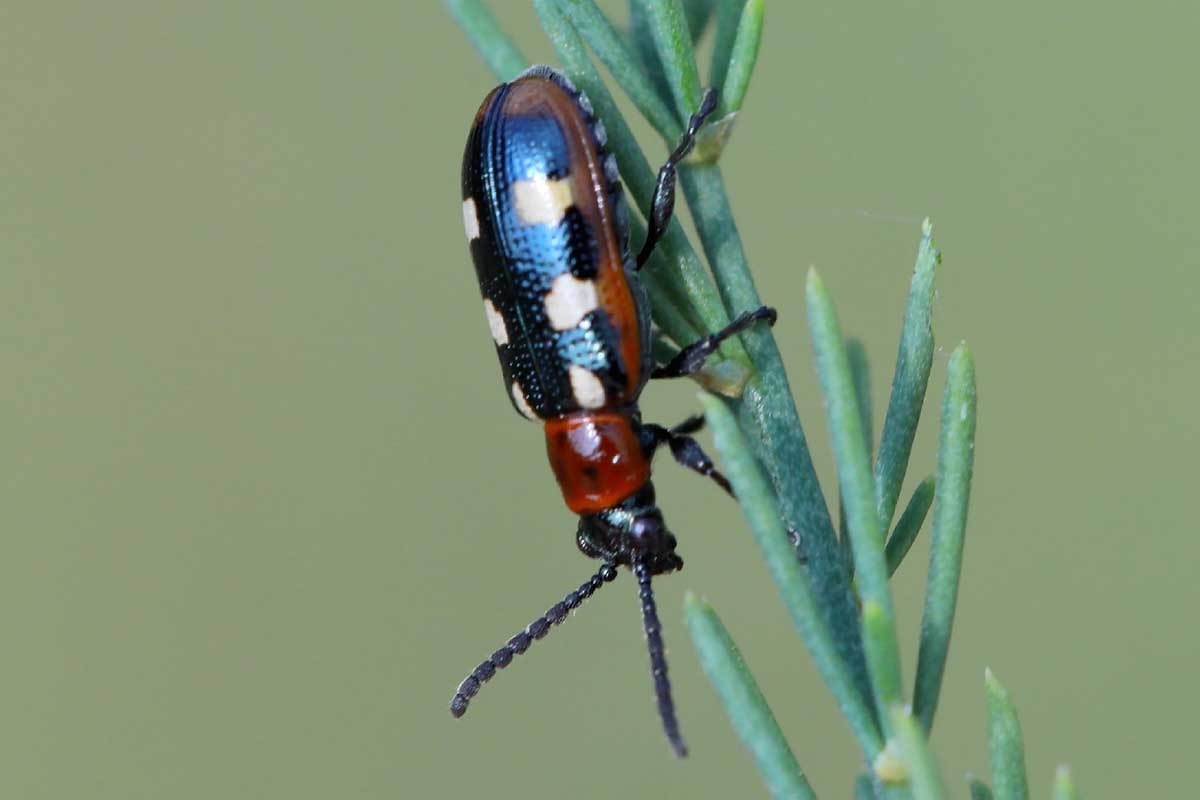
The common variety is mostly black with white splotches and an orange border on their backs, and the larvae of these are gray with a black head.
Spotted types are primarily orange with black spots and the larvae are orange.
Don’t confuse them with ladybugs, aka lady beetles, which are more rounded and dome-shaped.
The adults lay eggs on the spears, and when they hatch, the larvae crawl to the ferns and start feeding.
After getting their fill over a few weeks, they plop onto the soil and dig in to pupate into adults. Then, sing it with me, the cirrrrcle of life continues.
Common ones are usually out of the garden by June, and spotted by July.
When they feed, the larvae devour the ferns, depriving the plant of nutrients and resulting in stunted growth. The stalks turn brown and the tip bends, creating a hook-like shape. Their feeding also leaves the plants exposed to disease.
If you see beetles, pick them off right away and drown them in soapy water. Ladybugs, parasitic wasps (Tetrastichus asparagi), and green lacewings are natural predators, so invite them to hang out in your garden space.
Beneficial nematodes are also an effective treatment that may be used to eradicate these pests.
Heterorhabditis bacteriophora (Hb) nematodes parasitize the beetles and then release Photorhabdus luminescens bacteria.
Toxins released by the bacteria kill the insect pests. This is an excellent, chemical-free solution.
You can find NemaSeek™ Hb beneficial nematodes available in a variety of package sizes from Arbico Organics.
Select the option that is the best fit for your square footage, and follow package instructions for best results.
Asparagus Miners
The asparagus miner (Ophiomyia simplex) is a small black fly that damages the stems in particular as it feeds, giving them red, unappetizing markings.
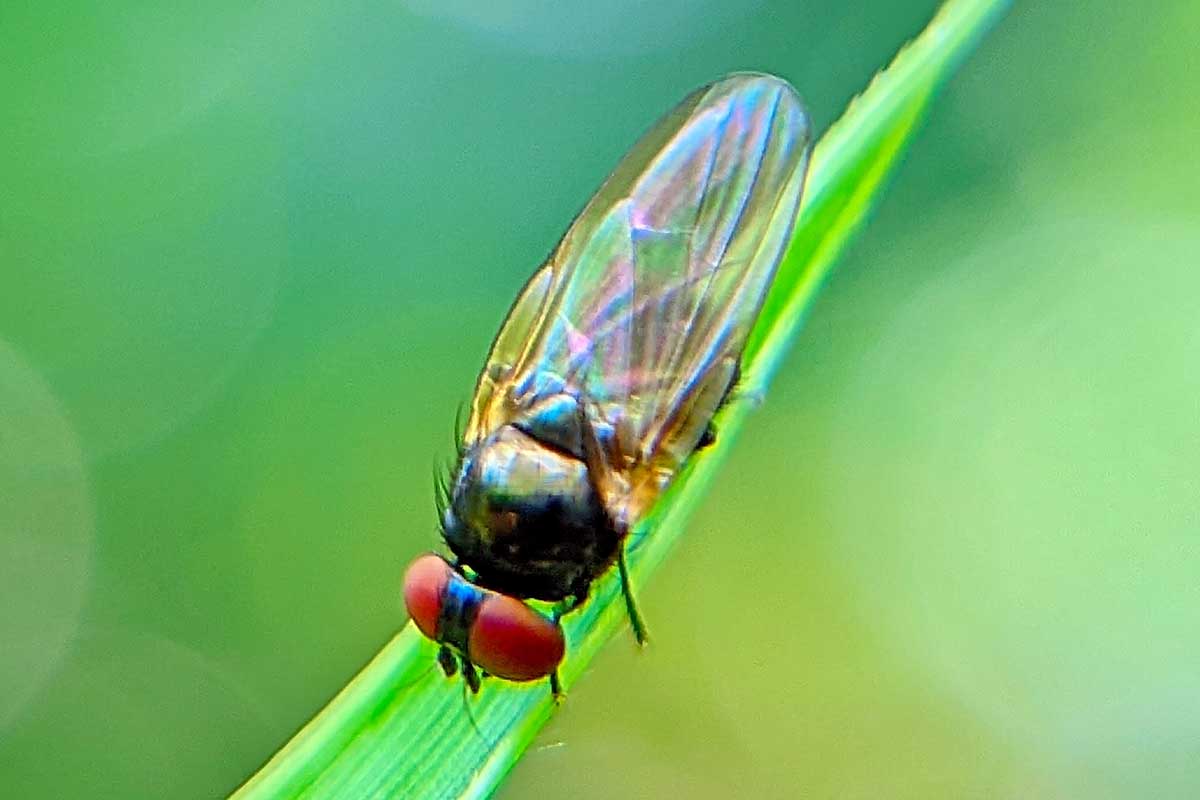
These flies are tiny, about a tenth of an inch long, and they lay teeny-tiny eggs at the base of stalks. But you probably won’t notice them, so don’t wait to see those for confirmation of an infestation.
The larvae feed on the stalks, causing the markings, and they can also girdle the stems. They may spread crown and root rot.
These pests have two generations per year in most areas of the US, one in late spring and another in late summer.
Preventing large populations from building begins with early removal of the foliage in winter. Sprays aren’t highly effective, so focus on prevention and exclusion using netting.
Japanese Beetles
Japanese beetles (Popillia japonica) are kind of pretty. With their iridescent-green or coppery-brown coloring, these scarab-like beetles might look fun, but they destroy above-ground foliage.
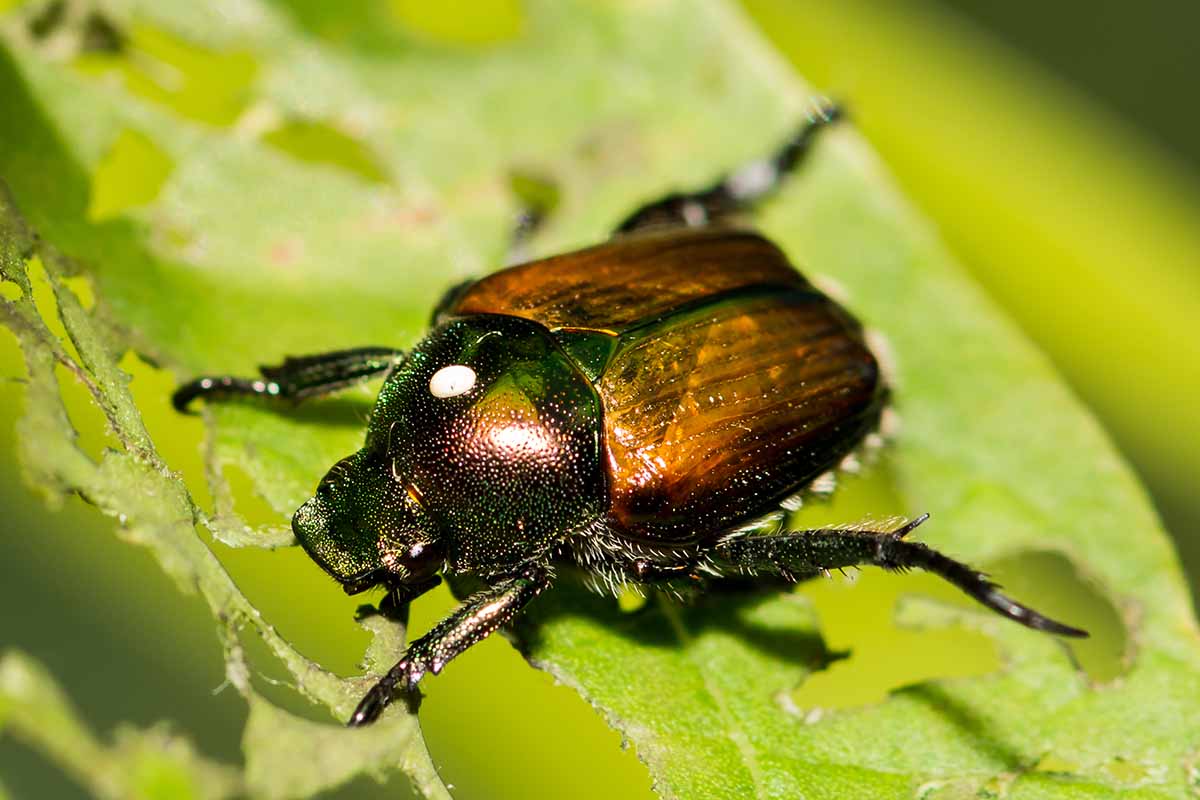
These can be kept away from your crops with organic sprays, pheromone traps, or the introduction of natural predators.
Try attracting birds, or letting chickens run through the mature patch.
Read our guide for tips to identify and control Japanese beetles.
Disease
I don’t make the rules. If I did, I promise, I would make pathogens a lot less attracted to asparagus. But until I’m in charge, we’ll have to deal with the many pathogens that can infect this vegetable.
By the way, to learn more about these common asparagus diseases, plus a few others, and how to treat them, check out our guide.
Here are the most common diseases you may encounter:
Crown and Root Rot
Fusarium and Phytophthora are two pathogens (a fungus and an oomycete, respectively) that may afflict roots, crowns, and lower stems of asparagus.
Rot creates unattractive, damaging patches of red on stalks, yellows above-ground foliage, and reduces yields.
As this happens to stressed plants, preventive measures are the only key to avoiding the problem: ensure adequate watering, reduce pest pressure, and avoid crown damage. When you replace crowns, avoid placing the new ones in the same area.
Read more about identifying and treating crown and root rot here.
Purple Spot
Reddish-purple spots on stalks and brown lesions on the ferns are the result of another fungal culprit, Pleospora herbarum.
To prevent purple spot, remove dead foliage as early as possible and water at the soil level rather than on foliage.
As with most fungal pathogens, moisture is key to the spread of this disease.
Read more about identifying and treating purple spot here.
Rust
Rust only affects the foliage. You’ll see it change color to yellow and brown in affected plants, leading to foliage loss.
Burning and early removal of foliage may be done preventively, as well as ensuring that crowns are planted with ample space for maximum airflow.
Read more about preventing and treating asparagus rust here.
Harvesting
Some sources state that freshly planted crowns must be left alone for at least the first few years for the patch to become fully established. But if you ask me, you have a little bit of wiggle room.
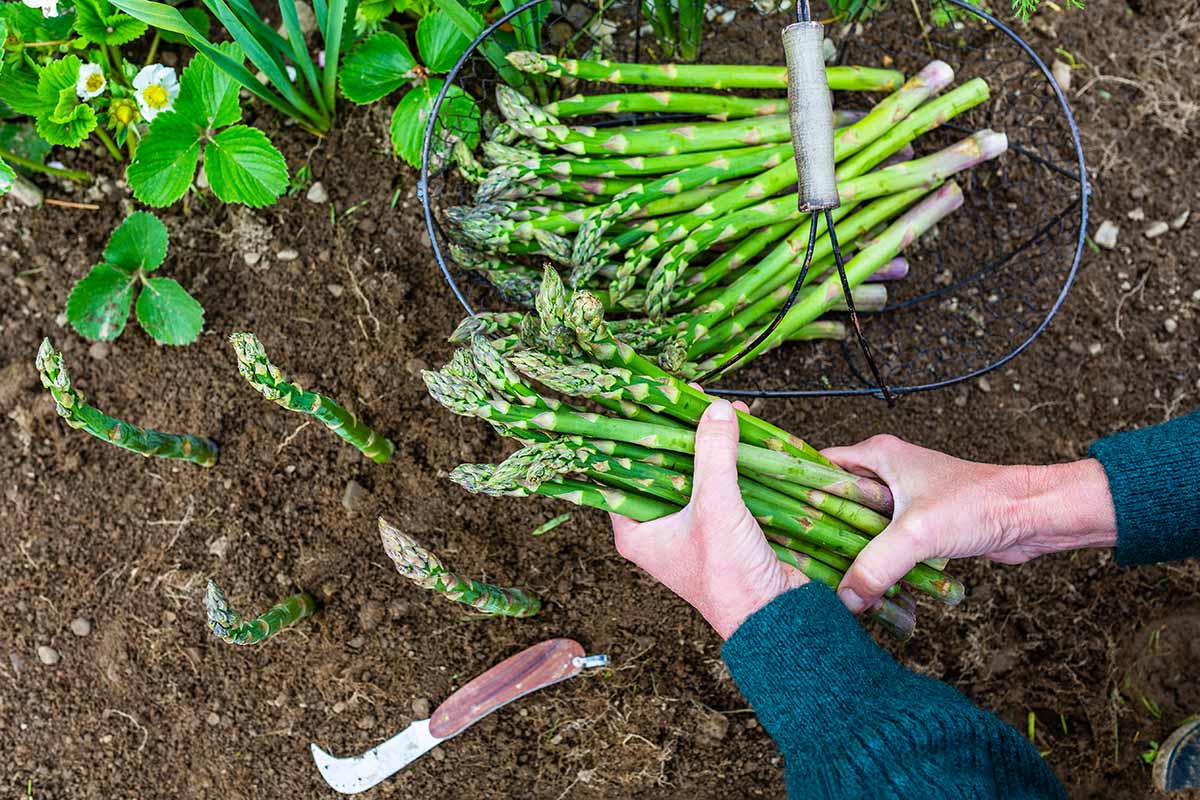
You may want to do this, just to be safe. But after the first year, I say you can get away with harvesting just a few stalks from your young crowns.
From this point forward, from the time when you first notice the spears rising from your planted crowns, plan to observe them closely. This isn’t a plant that’s ready for harvest all at once.
The asparagus harvest season lasts from spring until the summer solstice at the latest.
Since individual spears will emerge at different times, you will have to assess each one for readiness by checking a few important details:
Length
This can be determined based on preference and the qualities of your selected cultivar, but the optimum length of most asparagus spears is nine inches.
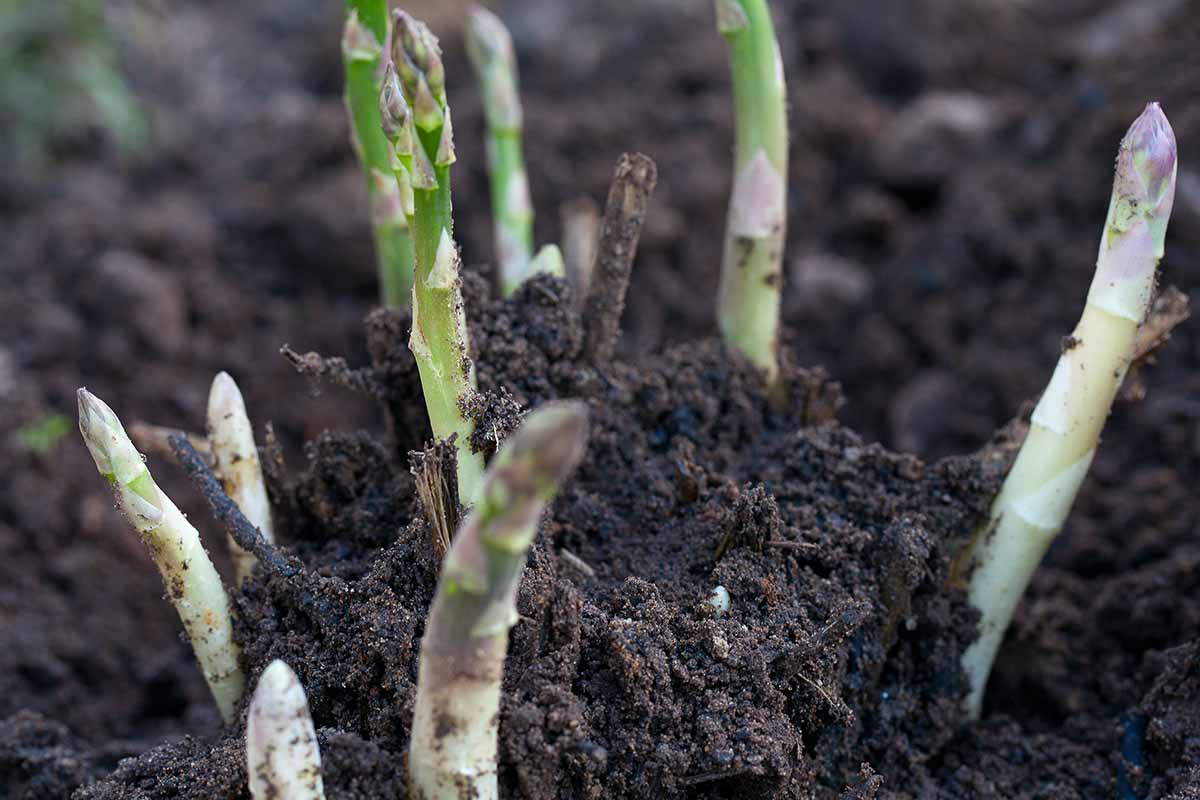
At this height or taller, the tips or buds will begin to open don’t wait too long or they’ll pass their peak; any shorter, and your harvest will yield less product.
Thickness
More so than length, size in terms of diameter at picking time can be a matter of preference as well.
You can harvest asparagus spears of any thickness or circumference, large or small, and enjoy them immediately or briefly store them for eating. Thinner spears tend to be more tender.
Tip Appearance
The purple, green, or blanched pointed tips are the most delectable part of the stalk; as it rises up, this bud unfolds to reveal giant, feathery ferns of towering inedible foliage.
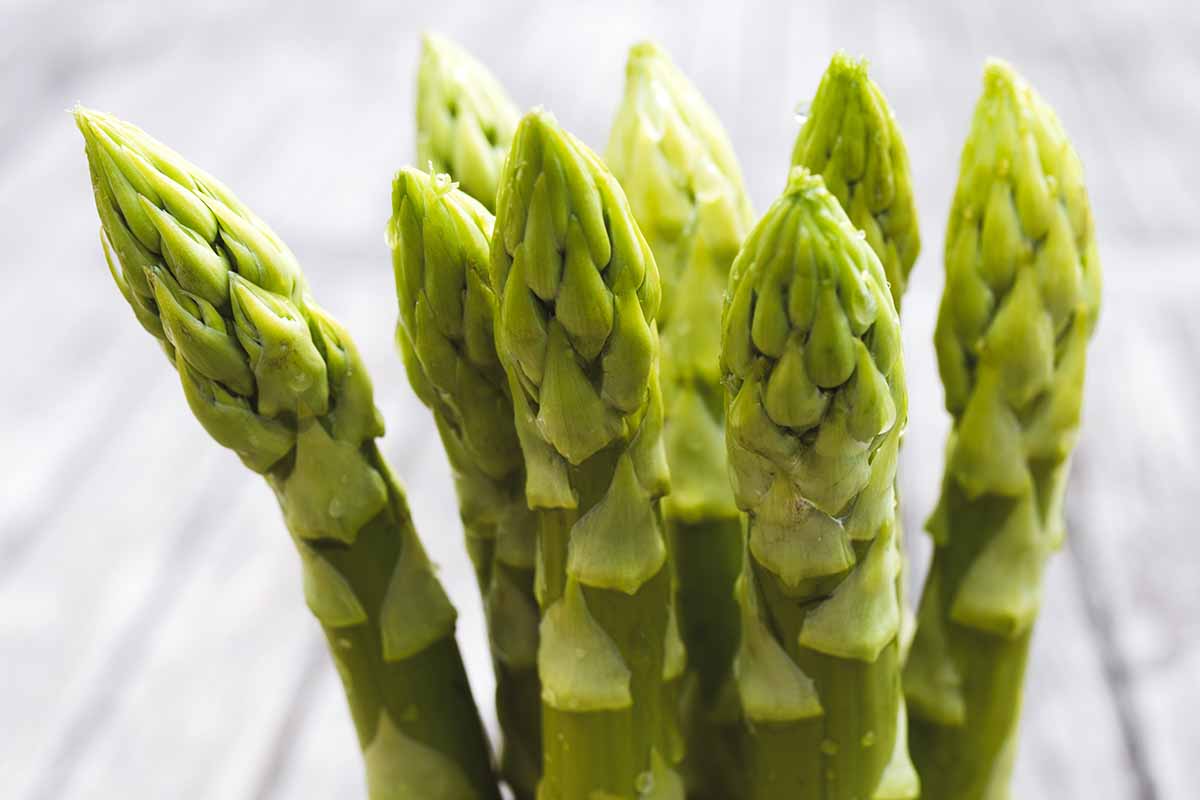
Pick stalks while the bud is still closed, or just barely clustered with small, whitish-yellow side-shoots – and before those too begin to branch off.
The more the tip opens, the less tender and tasty the stalks will be.
Color
Spears should always be green with purple buds, or purple with white buds if you’re growing a purple variety. Blanched, they should be completely white.
If any spears look discolored or bruised, yellow or red, or even appear slightly translucent at the tip, this could be the result of early-season frost damage, and these will be inedible.
Texture
If you particularly fear frost damage, feel the stalks before you pick them.
If stalks feel limp and pliable rather than supple and crisp, they have likely succumbed to frost damage and are no longer edible.
The best time to pick asparagus is during the morning.
On warmer days, you’ll see stalks getting taller and taller by the hour – so you’ll want to get them while they’re the optimum length, with bud tips still closed!
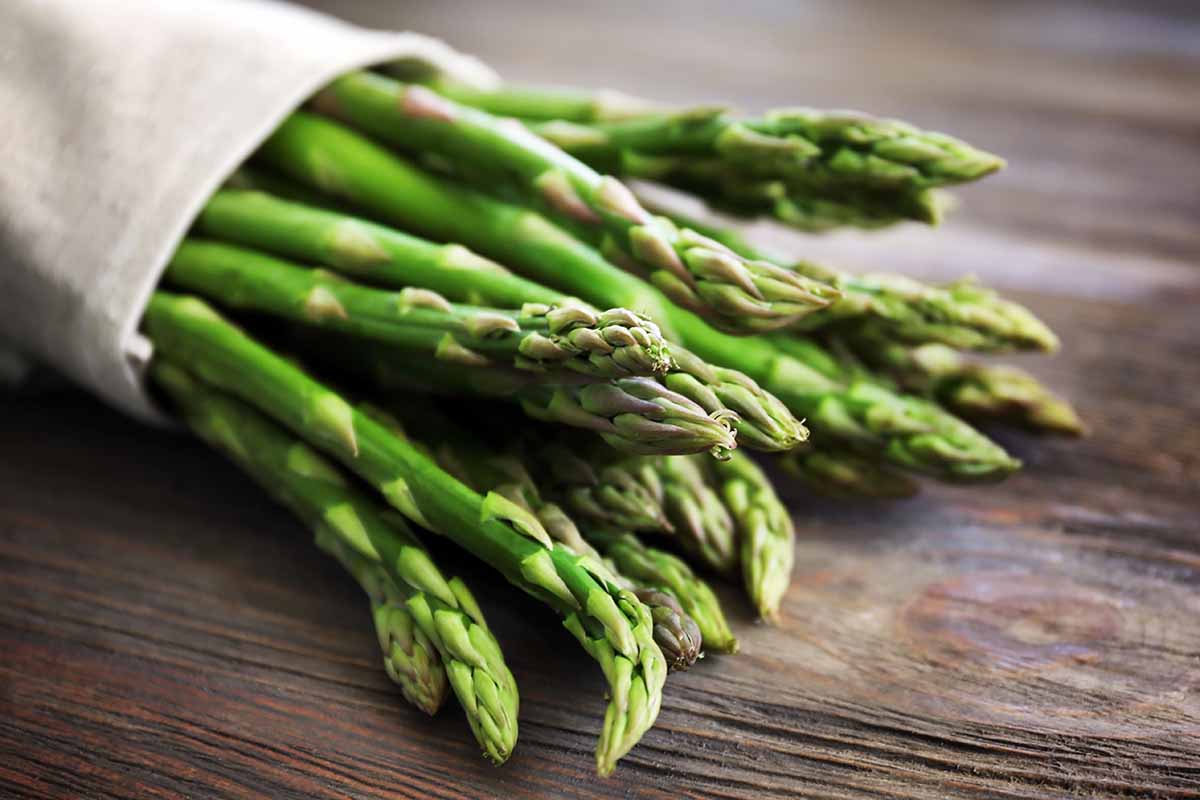
When you’re sure it’s time to harvest, take one hand and move your fingers down to the very base of the stalk, right to where it rises above the soil. Using your thumb and forefinger, pinch the stalk at its base and bend it until it cleanly snaps away.
If you don’t want to get your fingers dirty, you may use a knife to cut the stalks, right above the soil line.
Once you’ve picked all the stalks that are ready from your bed, you’ll want to store them correctly if you don’t plan to use them immediately. We’ll provide some pointers in the next section.
Don’t keep them at room temperature or in the sun for too long afterward, or they’ll wilt and go limp!
The next day, and throughout the rest of the season, keep an eye on your bed every morning for more harvestable stalks.
You’ll want to keep up a daily picking routine so the tasty stalks don’t have a chance to open up to unfurl the plant’s tall fronds.
That’s something you’ll only want to allow to happen towards the end of the season, when there’s nothing left worth harvesting.
With the arrival of the first truly hot weather in the 90s or above in your region, usually coinciding with the beginning of summer though this may be later in far northern climes, you will likely start to notice that the stalks rising from your crowns are thinner, spindlier, and less appetizing-looking, though this is not always the case.
When this happens, or if you’re growing young crowns that need more time to mature, leave them be and allow them to grow into tall fronds.
This allows the whole plant to build its stores of energy and readies it for a great harvest the next spring!
Maybe you want to push to get the most harvest out of your patch, but remember this tidbit of wisdom: the earlier you let your plants go to frond and flower, the healthier, more robust your asparagus will be next year!
If the spears are too thin, read our guide to learn why this happens and how to plump those puppies up.
Preserving
If your patch is successful and productive you could be pulling in a pretty decent amount of delicious spears every day, week after week!
It’s important to store your asparagus correctly to avoid letting all that hard work go to waste.

Store spears bundled together, with all tips pointing the same way and cut ends pointing in the other direction. This helps to avoid unintentional damage to the tips during handling and in storage.
Putting them in a plastic or paper bag in the fridge works well, though picking up and moving the bag can wear away or damage tips.
You can also store them in a small food-grade wax box, which can be moved, opened, and shut without affecting the stalks. Drape a plastic bag over the stalks within the box to retain moisture.
Leaving stalks in the fridge uncovered will allow them to dehydrate quickly, impacting flavor and texture, with limp, mushy, and floppy results.
To ensure maximum storage life, sprinkle a bit of water on the picked or sliced ends – but not the tips – as soon as they go into the fridge, to help rehydrate them.
My favorite way to store asparagus is in the same way you might store cut flowers. Place string or a rubber band around the stems to bundle them and hold them upright.
Place the cut ends in water so they’re submerged about an inch deep in a shallow dish.
Storing the bundled asparagus upright means the spears are less likely to be damaged, and they’ll remain well hydrated until you’re ready to use them.
Stored correctly, asparagus spears can stay in great condition for up to about two weeks.
Recipes and Cooking Ideas
The most common way to prepare this garden delicacy is by sauteing those delicious tips, maybe with that classic bit of butter and lemon juice.
Roasting them for a little while in the oven is another popular choice. But did you know you can also blanch, boil, or steam them as well, for a more delicate eating experience?
White blanched asparagus is particularly suited to blanching or steaming, since it tends to have a more delicate flavor profile than the typical green or purple spears.
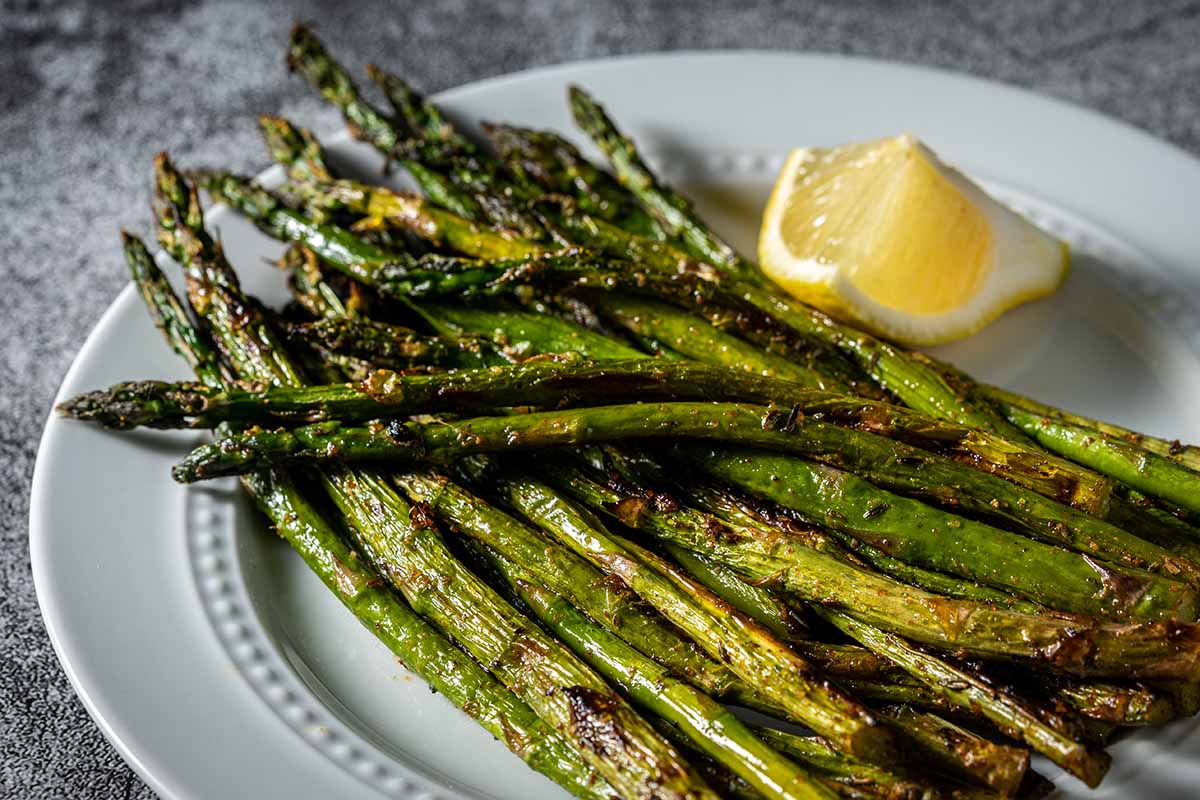
White asparagus spears tend to be stringier, and you may elect to peel some of the more fibrous outer layer from thicker stalks before cooking.
If you’re growing purple asparagus, this type may be so tender and sweet that you can add it raw straight to salads! Give it a rinse and a quick chop, and you’re ready to go.
Or toss it with some fruit like what you’ll find in this salad recipe from our sister site, Foodal.
Grilling and pan-searing are excellent cooking methods to try as well, bringing out more interesting flavors the more charred they get on the outside.
How about a lemon asparagus risotto? Foodal has a delicious, foolproof recipe to try.
And on those cooler spring days, a little soup is never amiss. Try whipping up Foodal’s creamy asparagus soup.
Quick Reference Growing Guide
| Plant Type: | Herbaceous perennial | Foliage Color: | Green |
| Native to: | Mediterranean coastal regions of Europe, Asia | Maintenance: | Moderate |
| Hardiness (USDA Zone): | 3-10 | Tolerance: | Freezing temperatures |
| Season: | Spring | Soil Type: | Loose, rich, loamy |
| Exposure: | Full sun | Soil pH: | 6.5-7.0 |
| Time to Maturity: | 4 years | Soil Drainage: | Well-draining |
| Planting Depth: | 1/2 inch (seeds), 6-12 inches deep (crowns) | Attracts: | Birds |
| Spacing: | 12 inches | Companion Planting: | Alliums, herbs, marigolds, nightshades, strawberries |
| Height: | Up to 8 feet | Order: | Asparagales |
| Spread: | 4 feet | Family: | Asparagaceae |
| Water Needs: | Moderate | Genus: | Asparagus |
| Common Pests and Disease: | Asparagus beetle, asparagus miner, Japanese beetle; Crown and root rot, purple spot, rust | Species: | Officinalis |
The Taste of Spring
Have you grown enough annual veggies, and think you’re ready to tackle asparagus next? After reading this comprehensive guide, I’d bet you are!
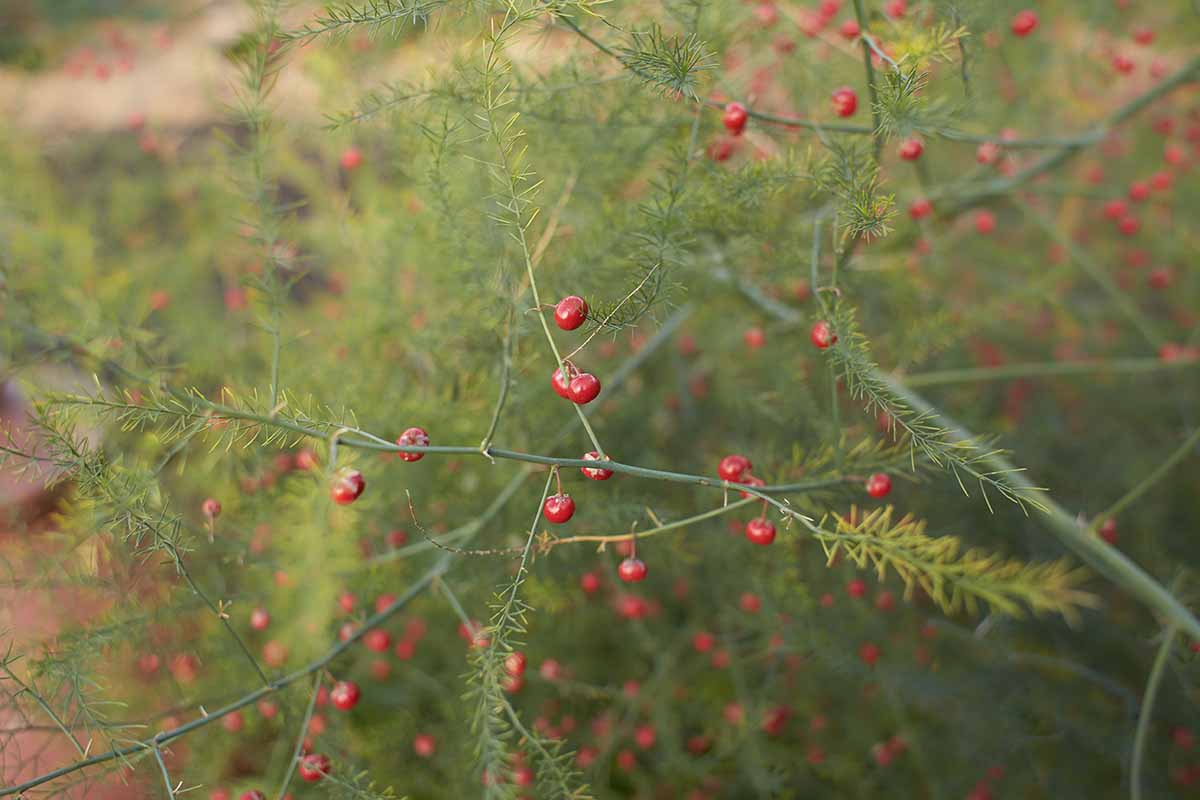
If you want to tend to, eat, and enjoy a healthy perennial food source that will come back again and again for years, asparagus is the one to try – and if you do it right, it will become a beautiful, delicious, and semi-permanent addition to your garden or yard.
Ordering crowns and planting them is pretty easy.
With only a few important management tips to follow, the most you really have to do is harvest the spears regularly when the time comes – and once harvest season is over, just sit back and watch their statuesque fronds billow and grow, collecting energy for more spears next year.
Of course, watch out for the few bugs and diseases that can plague your patch.
Are you ready to plant asparagus? What are your personal experiences with growing, tending, and eating this delicious produce? Please feel free to comment below!
Once you’re ready to add a few other vegetables to the garden, you might find these guides useful:
